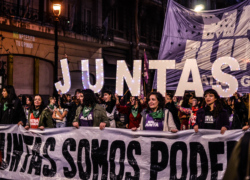Book Review: Voices of Change in Cuba from the Nonstate Sector

This is a book review by Ted A. Henken, Ph.D., Baruch College, City University of New York.
Voices of Change in Cuba from the Nonstate Sector
Carmelo Mesa-Lago, Roberto Veiga González, Lenier González Mederos, Sofía Vera Rojas, and Aníbal Pérez-Liñán
University of Pittsburgh Press, 2018
On December 5, 2018 – two days before major new legislation reigning in Cuba’s fledging private sector was to take effect – Cuba’s new, 58-year-old President Miguel Díaz-Canel took to Twitter to announce a modification of the law. “Today on the show Mesa Redonda, the heads of various ministries will give an update on the situation of Self-Employment. We are confident in collective leadership and the constant link with the people, guaranteeing their participation in the revolutionary tasks and decision-making.” Here, Díaz-Canel was obliquely referring to the resounding outcry among Cuba’s emerging entrepreneurial class – known colloquially as cuentapropistas – that the new set of regulations were both overbearing and onerous. While the new self-employment regulations were originally drawn up behind closed doors without the input from Cuba’s cuentapropistas themselves, after they were revealed to the public on July 10, 2018, the government was met with a sustained pushback and pleas for repeal or relief when it called local meetings with entrepreneurs to explain the new regulations and instruct them on how they could best be followed.
When the new regulations took effect on December 7, two of the most consistently criticized (if not the most fundamental) aspects of the new law had been removed: Cuban entrepreneurs would still be able to hold more than a single business license and the size of Cuba’s popular private “paladar” restaurants would only be limited by the physical parameters of the actual dining area, not by the arbitrary and infamous “50-chair” rule. Pushing back himself against claims that this 11th hour repeal represented a setback for his new government, President Díaz-Canel Tweeted again on December 7: “There is no reason to believe that rectifications are regressions, nor should they be confused with weaknesses when the voices of the people are heard. Revolution is changing everything that should be changed. None of us can do as much as all of us together. #WeAreCuba #WeAreContinuity.”
Such a statement conveniently ignores the fact that “the voices of the people” have been sounding off on the wrongheadedness of existing self-employment legislation for many years, especially so during the 11-month freeze in the issuance of new licenses in the most popular and lucrative occupations between August 2017 and July 2018 when the government was effectively deaf to them. Indeed, it was this initial deafness that led the government to draw up laws almost universally reviled by the private sector and then forced them to change course after the laws had already been published. Would it not have been better to listen to the “voices of the people” sooner and more systematically?
In the original 2016 Spanish language version of the 2018 book under review here in English translation – Voices of Change in Cuba from the Nonstate Sector – the authors quote a cuentapropista who advises the government to “allow free reign to the fertile imagination we Cubans are exhibiting, which should be done unhindered and unrestricted; the government should facilitate that flow, not obstruct it, and control only what must be controlled.” Given that such advice was given in Spanish in a book presumably available in Cuba to curious policymakers who say they care what the “voices of the people” are saying, one would expect to see some echo of it in future legislation. However, it is more likely that such advice has gone largely unheard and unheeded among Cuban policymakers as it clashes with the centralized, command and control orientation of the Cuban state socialist system. Indeed, more to the point is this direct response from a private home seller when asked by the book’s authors what he would like to see change or improve: “I would like that those who govern us think more on how to make citizens’ lives simpler, and less about how to preserve ideas that have been demonstrated to bring nothing more than destitution.”
The most recent episode in the ongoing, unpredictable saga of Cuba’s never-say-die nonstate sector (NSS) chronicled above only makes books like the one under review here more vital and important. This is the case because – as the book’s title Voices indicates – its primary goal is to understand, analyze, and share as widely as possible the experiences, opinions, obstacles, and desires for change of a wide range of pioneers in Cuba’s emergent if unwieldy NSS, which includes not only the self-employed private sector cuentapropistas referred to above, but also usufruct farmers, members of new non-agricultural cooperatives, and the buyers and sellers of private dwellings. Indeed, one of the most innovative and rich aspects of the book is that it is based on a meticulous analysis of 80 intensive interviews carried out in Cuba with members of these four groups during 2014-2015. As someone who has published a book and multiple articles on Cuba’s cuentapropistas based partially on direct interviews with them, I can attest to the great difficulty and thus great value for both scholars and especially policymakers of hearing these unvarnished voices. I can also say that the rigorous interview methodology employed by the authors and the wide scope of experience and occupation among the interviewees is surely unparalleled in the existing scholarship on the subject.
The authors begin their study by justifying their interest in Cuba’s NSS by claiming that it has grown from an estimated 20% in 2005 to 29% of the island’s labor force by 2015. Still, they openly admit that Cuban statistics on the exact size of various sectors of its labor force are questionable, citing competing official figures that put the NSS at anywhere from 22.8% to 35.8% of the labor force. The other half of their justification of their focus on Cuba’s NSS is that they believe it “has the potential to transform the predominant state economy (71 percent of the labor force), which is in a precarious situation” (p. 1), to say the least. Apart from sharing the voices of NSS actors, the authors’ goal in the book is to attempt to quantify the sector and identify more precisely the four groups which make it up. In this vein, we learn that cuentapropistas make up the lion’s share of the nonstate labor force at 41.4% (or 483,400 licensees in 2015, a total which has risen to nearly 600,000 by 2019). This is followed by usufruct farmers who comprise 26.7% of the nonstate labor force (312,296), and by the members of Cuba’s various agricultural cooperatives who constitute 19.8% of the nonstate labor force (231,500). The remainder of the sector is made up of small private landowners (8.5% or 99,500), peasant farmers (2.8 or 32,000), and tenant farmers (0.2% or 2,843). Ironically, despite initial expectations of great expansion given its supposedly more “socialist” form of labor organization and management, Cuba’s new experiment in non-agricultural cooperatives (NACs) makes up only 0.5% of the nonstate labor force at just 5,500 members.
Apart from the merely statistical analysis cited above, this short 178-page book is in fact quite layered with many rich and complimentary elements. On the quantitative front, we are given access to a plethora of otherwise unavailable information about Cuba’s NSS including the demographic characteristics of its workers (age, sex, race, and education level). Additionally, through the responses to the different questionnaires administered to the 25 cuentapropistas, 25 usufruct farmers, 25 buyers, sellers, and brokers of private homes, and the five members of new non-agricultural cooperatives who participated in the study, we learn about their levels of satisfaction, previous occupations, profits, reliance on investment capital, remittances, or microcredit, numbers of employees, competition, use of advertising, and plans for expansion. Indeed, one finding the authors readily admit was surprising to them is that levels of satisfaction are very high among NSS workers despite the many bureaucratic and frankly political obstacles they have to contend with on a daily basis (p. 121).
One of the most useful parts of the book is its extended sections where these NSS workers can sound off on the principal problems they face and the changes they desire. For example, in Chapter 2 on self-employed workers, we learn that their main challenges are access to inputs and the need for a wholesale market, followed by the thick bureaucracy and restrictive legislation. Likewise, according to the authors, the question about desired changes “is essential for hearing the voices of the self-employed workers and publicizing them so that they are heard.” Indeed, “their desire for change is concomitant with the problems they identified” and include “more freedom and fewer regulations” and “better access to inputs and lower prices” (pp. 41-42). Despite such rigorous quantitative crunching of the numbers collected by the authors of the study, their book is also quite honest about the near impossibility of conducting scientifically-sound, generalizable survey research in Cuba today. For this reason, they insist that their findings while valuable and indeed unprecedented are more indicative than representative.
Three other elements give this book a special value as a resource for further research on the subject by other scholars. First, on the qualitative front prior presenting any survey data, each of the book’s four core chapters (Ch. 2 on cuentapropistas, Ch. 3 on usufruct farmers, Ch. 4 on NACs, and Ch. 5 on private home sales) begins with an extended “antecedents” section where the authors give an encyclopedic survey of the existing scholarship and recent government policies in the sector, including data on size and trends, key characteristics, advances, obstacles, and impacts. Taken together, these four subsections of the book represent an ideal place for any curious observer to gain a grounding in the policy and economic context that preceded the recent reforms in these sectors of the Cuban economy.
Second, the book ends with a highly original conclusion that attempts to draw links and comparisons among the book’s four somewhat disparate subsections, while also drawing together the various overlapping themes and lessons of each subsection to arrive at an actionable set of general recommendations and specific suggestions for Cuban policymakers should they be interested in heeding these “voices of the people.” These include eliminating excessive bureaucracy, doing away with the occupational list of allowable activities and replacing it with a short list of off-limits ones, allowing university professionals to become self-employed, reducing excessive taxes (especially ones on hiring additional employees), allowing the NSS to contract with state enterprises, creating wholesale markets and facilitating credit for the NSS, allowing the NSS to import inputs and export its products, and finally moving beyond the “experimental stage” of non-agricultural cooperative development (p. 138-141).
Third, in a laudable effort at transparency, the authors provide two final appendices where they share the five interview questionnaires used in the study and a list of the 18 common questions asked of all respondents.
As someone whose own work on the Cuban economy has been deeply influenced by that of Carmelo Mesa-Lago – the senior author of the book under review – I should end my commentary by mentioning a number of the other enviable characteristics that this book shares with much of his other scholarship in a polarized field that often suffers from work that “gives off more heat than light.” First of all, the book is an exemplary showcase of the potential fruits of cross-border, cross-disciplinary collaboration. Mesa-Lago, a Cuban-American economist, produced the study working in concert with Roberto Veiga and Lenier González, who conducted and compiled the interviews on the ground in Cuba. Veiga and González are two leading Cuban public intellectuals who have studied political science and sociology, respectively, and co-edited the renown journal Espacio Laical until 2014 before cofounding one of the most important and influential journals in Cuba in the present day, Cuba Posible. This is to say nothing of the collaboration of Sofía Vera Rojas and Aníbal Pérez-Liñán, doctoral student and professor of political science, respectively, at the University of Pittsburgh, who worked together in processing and tabulating the interviews.
A second characteristic that makes this book particularly valuable is its immersion in and fine use of the Cuban literature on the NSS (produced in Spanish in Cuba), including social scientific work from the academy and both official and independent journalism. Third, Mesa-Lago has made sure that this book – like many of its predecessors – appear in both the original Spanish as well as in English so that its impact and influence are felt as broadly as possible. Finally, Mesa-Lago is to be celebrated for doing the hard work of establishing credible statistical baseline on so many disparate aspects of the Cuban economy (and admitting openly when such a baseline is an ephemeral dream). As a result, this short book is chock-full of a series of amazingly detailed tables and figures (there are 27 such tables and figures in Ch. 2 on cuentapropistas alone; and 57 tables and 32 figures in the entire book), all of which are clearly labeled and expertly unpacked in the text, and some of which are original calculations from a number of separate and incomplete source documents. Mesa-Lago’s success in establishing a common statistical ground for scholars, policymakers, and pundits who often disagree in their analyses and opinions is quite an accomplishment for the polarized field of Cuban Studies. As American politician and public intellectual Daniel Patrick Moynihan is known to have quipped: “Everyone is entitled to their own opinions, but they are not entitled to their own facts.”
The French version of this review will be published in Cahiers des Amériques latines, n°91 (https://journals.openedition.org/cal/) in summer 2019 by the Institut des Hautes Etudes de l'Amérique latine (IHEAL) of the Sorbonne-Nouvelle, University of Paris III. The English version is being published here with the kind permission of the editors.



















